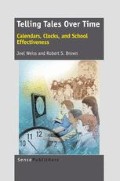Abstract
The first article of the July 1 2009 ASCD Smart Brief was a good news story on school improvement: Math educators at a struggling Florida elementary school locked away their textbooks before the start of last year, rewriting the curriculum themselves in an approach that helped them post large gains on state tests and raised their school’s grade from a D to a B.
Access this chapter
Tax calculation will be finalised at checkout
Purchases are for personal use only
Preview
Unable to display preview. Download preview PDF.
References
Berliner, D., & Biddle, B. (1995). The Manufactured Crisis. White Plains, New York: Longman.
Bloom, B. et al. (1956). Taxonomy of Educational Objectives, Handbook l, The Cognitive Domain. New York: McKay.
Bloom, B. (1964). Stability and Change in Human Characteristics. New York: John Wiley.
Bracey, G. (2008). The 18th Bracey Report on the condition of public education: Schools-are-awful bloc still busy in 2008. Phi Delta Kappan, 90(02), 103-114.
Bridgeman, B., & Shipman, V. (1975). Predictive value of measures of self-esteem and achievement motivation in four-to-nine old low-income children. ETS Technical Report PR 75—24. Princeton, N.J.: Educational Testing Service.
Brown, R., & Sinay, E. (2007). School and District Effects in the Literacy and Mathematics Achievement of Toronto District School Board Students as Measured by Provincial Assessment. Paper Presented at the European Association for Research on Learning and Instruction (EARLI) Conference, Budapest, Hungary, August.
Coleman, J., & others. (1966). Equality of Educational Opportunity. Washington, D.C.: U.S. Government Printing Office.
Cuban, L. (1993). How Teachers Taught: Constancy and Change in American Classrooms 1880–1990. New York: Teachers College Press.
Cuban, L. (2009). Hugging the Middle: How Teachers Teach in an Era of Testing and Accountability. New York: Teachers College Press.
Educational Quality Accountability Office (2012). The Power of Ontario's Provincial Testing Program. Toronto, ON: Ontario Educational Quality Accountability Office.
Entwistle, D., Alexander, K., & Olson, L. (1997). Children, Schools and Inequality. Boulder, CO: Westview.
Hanson, R., & Farrell, D. (1995). The long-term effects on high school seniors of learning to read in kindergarten. Reading Research Quarterly, 30(4), 908-933. (http://www.tampabay.com/news/education/k12/woodlawn-elementary-thinks-outside-the-book-to-pull-d-to-a-b/1014663)
Husen, T. (Ed.). (1967). International Study of Achievement in Mathematics: A Comparison of Twelve Countries. New York: John Wiley and Sons.
Jersild, A. et al. (1939). An evaluation of aspects of the activity program in the New york City public elementary schools. Journal of Experimental Education, 8, 166–207.
Jersild, A. et al. (1941). A further comparison of pupils in 'activity" and 'non-activity" schools. Journal of Experimental Education. 9, 303-309.
Johnson, D., & Brydon, R. (2012). Ontario's Best Public Schools: 2009-2011. Toronto, TO: C.D. Howe Institute.
Jones, L., & Olkin, I. (2004). The Nation's Report Card: Evolution and Perspectives. Bloomington, Indiana: Phi Delta Kappan Foundation.
Krathwohl, D., Bloom, B., & Masia, B. (1964). Taxonomy of Educational Objectives, Handbook II, The Affective Domain. New York: McKay.
Lim, S. (2009). Woodlawn Elementary thinks outside the book to pull D to a B. Tampa Bay Times, July1. (http://webcache.googleusercontent.com/search?q=cache:bg0mOuswwlMJ:www.tampabay.com/news/education/k12/article1014663.ece+Woodlawn+elementary+thinks+outside+the+book+Sylvia+Lim&cd=1&hl=en&ct=clnk&gl=ca)
Madaus, G., Russell, M., & Higgins, J. (2009). The Paradoxes of High Stakes Testing. Charlotte, NC: Information Age Publishing.
McCain, M., & Mustard, F. (1999). Reversing the Real Brain Drain: Early Years Study Final Report. Toronto, ON: Ontario Children's Secretariat.
New York Times. (1911). October 14.
New York Times. (1930). June 5.
New York Times. (1936). June 1.
New York Times. (1947). May 21.
New York Times. (1957). October 15.
New York Times. (1958). January 15.
Nichols, S.L., & Berliner, D.C. (2007). Collateral Damage: How High-Stakes Testing Corrupts America's Schools. Cambridge, MA: Harvard Education Press.
Rice, J. (1913). Scientific Management in Education. New York: Hinds, Nobel and Eldridge.
Rourke, E., & Ingram, F. (1991). International Directory of Company Histories, Volume 62. Farmington Hills, Michigan: The Gage Group.
Schenk (2009). What makes us happy? Atlantic, June. (http://www.theatlantic.com/magazine/archive/2009/06/what-makes-us-happy/307439/)
Smith, E., & Tyler, R. (1942). Appraising and Recording Student Progress. New York: Harper and Bros.
Stallings, J. (1975). Implementation and child effects of teaching practices in Follow Through classrooms. Monographs of the Society for Research in Child development (Serial No. 60), 40.
Tyack, D., & Cuban, L. (2005). Tinkering Towards Utopia: A Century of Public School Reform. Cambridge, MA: Harvard University Press.
Tyler, R. (1950). Basic Principles of Curriculum and Instruction. Chicago: University of Chicago Press.
U.S. Congress. (2002). The Elementary and Secondary Education Act (The No Child Left Behind Act of 2001). Washington: Congress.
Vaillant, G. (2002). George Vaillant Aging Well: Surprising Guideposts to a Happier Life from the Landmark Harvard Study of Adult Development. Boston; Little, Brown and Company.
Weiss, J. (1980). Assessing non-conventional outcomes of schooling. In D. Berliner (Ed) Review of Research in Education, 8. Washington, D.C.: American Educational Research Association.
Yau, M., & Brown, R. (2007). The TDSB EDI Kindergarten Cohort Study: An Analysis of EDI Assessment in Kindergarten and EQAO Results, 3 and 6 Years Later (Preliminary Findings). Toronto: Toronto District School Board (http://www.offordcentre.com/readiness/files/2008_05_26_SK_EDI_ and_EQAO_MYau.pdf)
Author information
Authors and Affiliations
Rights and permissions
Copyright information
© 2013 Sense Publishers
About this chapter
Cite this chapter
Weiss, J., Brown, R.S. (2013). Time Structures and the Canons of Testing. In: Telling Tales Over Time. SensePublishers, Rotterdam. https://doi.org/10.1007/978-94-6209-263-1_6
Download citation
DOI: https://doi.org/10.1007/978-94-6209-263-1_6
Publisher Name: SensePublishers, Rotterdam
Online ISBN: 978-94-6209-263-1
eBook Packages: Humanities, Social Sciences and LawEducation (R0)


